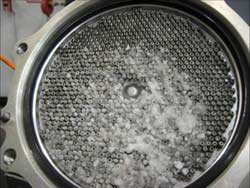European agency suggests redesigning of Boeing 777 engine part
14 March 2009
The National Transportation Safety Board has called for the redesigning of a Rolls-Royce engine component, after two engine thrust rollback events on Boeing 777 aircraft powered by Rolls-Royce engines.
The Safety Board also recommended that, after the redesign is completed, the new system be installed on all affected B-777 airplanes at the next maintenance check or within six months.
 ''These recommendations are being issued in response to the findings in two investigations - an accident and an incident - involving engine thrust rollbacks on Boeing 777-200ER airplanes powered by Rolls-Royce RB211 Trent 800 Series engines,'' it said, adding, ''In both cases a build-up of ice (from water normally present in all jet fuel) on the fuel/oil heat exchanger (FOHE) restricted the flow of fuel to the engine, resulting in an uncommanded engine rollback.''
''These recommendations are being issued in response to the findings in two investigations - an accident and an incident - involving engine thrust rollbacks on Boeing 777-200ER airplanes powered by Rolls-Royce RB211 Trent 800 Series engines,'' it said, adding, ''In both cases a build-up of ice (from water normally present in all jet fuel) on the fuel/oil heat exchanger (FOHE) restricted the flow of fuel to the engine, resulting in an uncommanded engine rollback.''
The first event, which is still being investigated by the UK's Air Accidents Investigation Branch (AAIB), occurred on 17 January 2008, when a Boeing 777 experienced a dual engine rollback on final approach and crashed short of the runway at London's Heathrow International Airport, it said. One passenger was seriously injured, eight passengers and four of the flight crew sustained minor injuries; the airplane was substantially damaged, it added.
The second event, the agency said, occurred on 26 November 2008, when a Delta Air Lines Boeing 777 experienced a single engine rollback during cruise flight over Montana while en route from Shanghai to Atlanta. Normal operations resumed after the flight crew followed Boeing's published procedure to recover engine performance; the airplane landed safely in Atlanta.
Boeing has since developed procedures to help prevent ice accumulation, and to recover thrust in cases of ice blockage. The company later modified the procedures, which became the basis of an airworthiness directive issued by the Federal Aviation Administration.
